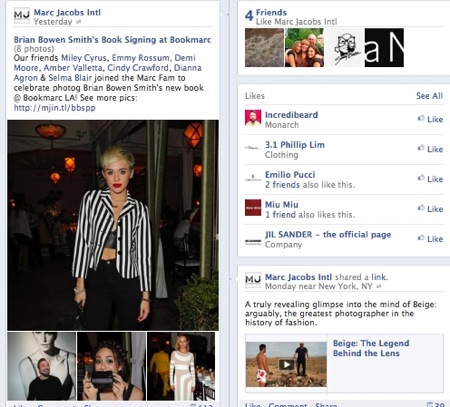Articles and News
How To Use Social Media Without Diluting Your Luxury Mystique | May 01, 2013 (0 comments)

New York, NY—Few successful luxury marketing strategies can ignore social media. Yet in many ways, social media defies the essence of luxury: social media is inclusive—indeed, the more people it reaches, the better—and it has no barrier to entry, making it accessible to all. Luxury brands, by contrast, aim to be exclusive and discerning, and price is a big barrier to entry.
How can a luxury brand make the most of social media without tarnishing its image? Do you want fans to like your page even if they can't afford your products? Can you really be accessible to all, yet offer something exclusive?
Luxury Daily recently hosted a webinar devoted to the topic. Panelists included Ralph Jovine, president and CEO of B Culture Media in Atlanta, GA, Gretchen Ramsey, vice president of strategy at McCann Worldgroup’s MRM in Philadelphia, PA, Ted Nadeau, president and COO of Style Coalition, New York, and Matt Peters, cofounder and creative director of Pandemic Labs, Boston, MA.
Panelists debated the balance between accessibility and exclusivity, offered tips to make the most of your social media strategy, and finally, how to measure your progress. Here were the key takeaways from the webinar:
It’s about the brand, not the product. Social media on a luxury level is all about the brand, said Jovine. The point of social is to convey, “who we are, not just what we sell,” he said. It’s about listening to what your target demographic is telling you, not the brand telling them what to buy. You can show product, but the primary message is the brand.
“Privacy and exclusivity create an aura and allure for a luxury brand,” said Ramsey. “Social media allows people into the brand.” But, she cautioned, be careful how far you pull the curtain back—like royalty, there needs to be a certain level of mystique maintained.
“Luxury brands are different than non-luxury brands [on social media], said Peters. “People define themselves by the luxury brands they use. It’s the difference between a man who buys a suit at Men’s Wearhouse and a man who gets made-to-measure at Brioni. The Brioni suit is part of who he is.”
Nadeau pointed out that luxury brands traditionally advertise in a very rigid way, but bringing their traditionally beautiful imagery into social media allows them to present a more playful and personal side that brings customers in and allows them more engagement with the brand.
Nadeau suggested the fashion designer Marc Jacobs as an example. Jacobs’ Facebook page is the gold standard, he said—it incorporates great product images, great images of how the brand’s stores are merchandised, and a glimpse into the designer as a person—even including his beloved dog.

A snapshot of Marc Jacobs' Facebook page. The page was praised for incorporating beautiful imagery with timely topics that offer insight into the designer's personality, rather than purely product focus.
Another outstanding campaign the panelists pointed to was for Dior cosmetics. In March, the brand introduced its new spring colors, and one day ran a special campaign announcing there would be a new post every 30 minutes. Consumers were very engaged that day, eager to see what the next post would be.
Make social strategy a priority and hire the right person to do it. The most important thing to remember is that social media is no longer a channel, emphasized Ramsey. It’s part of the ecosystem, part and parcel of every part of a brand.
“Too many brands think of social media as an afterthought,” said Peters. That’s wrong, he stressed. Your social strategy can’t be tacked on at the end of your marketing plan and given to an intern to implement. It’s far too important to do without a strategy.
“Be incredibly considerate of who you are hiring to be the voice of your brand. They must have something in their background to match up to the brand, especially in luxury,” emphasized Ramsey.
How to choose the channels. Which social media channels serve the needs of luxury brands the best?
“Each channel serves a unique purpose for the brand,” explained Ramsey. “Pinterest serves commerce, Twitter is about information and showing the brand is on top of what’s happening in culture, and Facebook is about people.”
Peters said, “The question is, ‘what platform is best for my brand,’ not what platform is best for luxury brands.”
But whatever the channel, content is still king. Whatever is put out there has to be of value to the consumer. The panelists pointed out that YouTube is not to be dismissed. It’s the first native spot for video, though they can further be embedded in other channels like Facebook or Twitter.
“Video is very powerful,” said Peters. “But don’t look at it as a platform, look at it as content. Luxury consumers may not watch a video every time, but when they do you can give a much richer experience of the brand with video.”
Indeed, two of the 10 social media videos Luxury Daily selected as the best for the first quarter of 2013 featured jewelry. Italian jewelry house Bvlgari featured one called “Dvels – The Film,” to push its new Man Extreme fragrance, while Chanel’s third chapter in its Inside Chanel series of videos, titled “Chanel and the Diamond,” featured the brand’s fine jewelry collection.
The importance of mobile and local. “The value [of mobile] for users often is a local approach,” said Ramsey. And Peters reminded the audience that Facebook is a platform, mobile is a device. A device, reminded Ramsey, that is becoming the center of the universe as more and more people will access your brand while on the go.
“Your strategy has to take into account users with all kinds of devices,” said Peters. “A computer has a full screen view. A tablet is smaller. And a phone has a very small screen.” Your digital presence has to take each of these into account; don’t just assume people will navigate your full-size page on a tiny screen.
How to measure social ROI. Finally, the panel discussed a key question that’s on every marketer’s mind: how to measure social media ROI? Panelists laughed and said that’s been the proverbial holy grail—because there is no one single metric to use.
“We look at social holistically,” said Ramsey. “You can track sales that are driven by social media, but it’s not always about sales. It can be about shifting a perception, making the public aware in advance of a new ad campaign, and so forth. We define the metric as your business objective. You can develop ROI models, but do your own model.”
Peters asked, “Why don’t we have ROI models like we do for email marketing or banner advertising? Because these are 10 years ahead of social. Where were they at the same stage?” If people do figure out an ROI model, they aren’t sharing it yet, he added.
“What excites me the most about social is that I allows for multichannel funnels [of marketing]. “It’s almost never one piece of marketing that drives someone to make a purchase. A man doesn’t see a BMW ad, then go out and spend $85,000 on the car.
“People see constant high quality communication, including traditional advertising, social, et cetera, it all contributes to the brand success.”
Top image: Fashion blogger Miugy, www.sofb/tkj.jp/miugy







